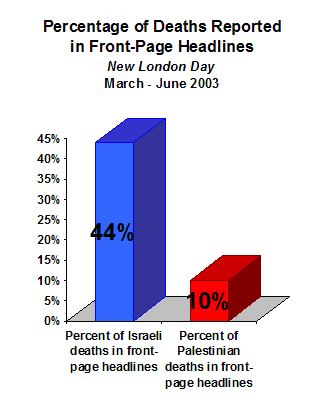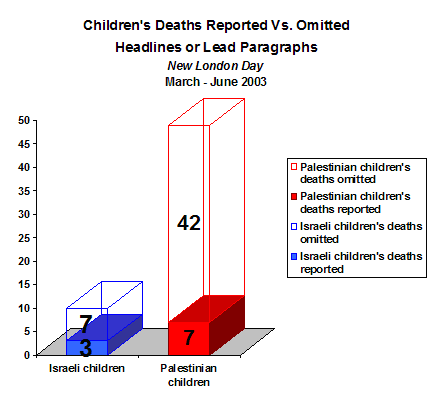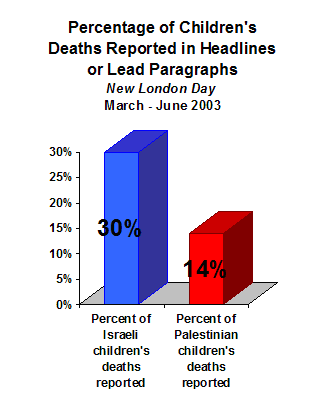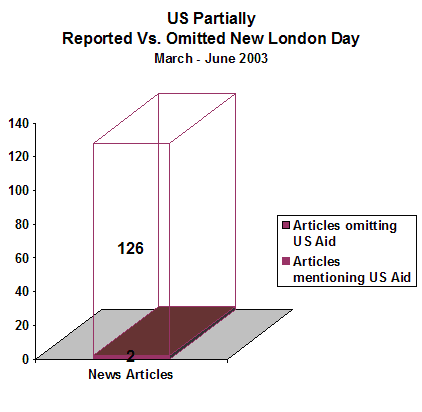

Media Report Card
Accuracy in Israel/Palestine Reporting
New London Day
March - June 2003
|
|
Abstract
Introduction
Methodology
Coverage of Casualties
Front-Page Coverage of Deaths
Coverage of Children’s Deaths
Coverage of Cumulative Totals
Coverage of US Connection
Recommendations
Conclusion
Endnotes
Appendices
Abstract
This 4-month study consists of a statistical examination of the New London Day’s news coverage of the Israeli-Palestinian conflict. The categories examined were coverage of deaths and injuries in general; children’s deaths; and the U.S. connection to this conflict, U.S. aid to Israel/Palestine.
Our findings indicate distorted coverage by the New London Day of these topics. We found a vast disparity in the likelihood of a death receiving coverage based on the ethnicity of the person killed, with Israeli deaths being two and a half times more likely to receive prominent coverage than Palestinian deaths. The New London Day reported on 159 %1 of the Israelis killed and only 62 % of the Palestinians killed in the headlines or first paragraphs of the 128 articles on the topic.
This discrepancy was even larger on the front page of the Day. Despite the fact that during this time nearly four times more Palestinians were killed than Israelis, the Day reported slightly more Israeli than Palestinian deaths in front-page headlines and lead paragraphs (31 and 26 respectively). By reporting nearly equal numbers of Israeli and Palestinian deaths on the front page, the Day creates the false impression of a balanced conflict, which does not reflect the reality where approximately four Palestinians die for every one Israeli.
This type of distortion was also present, and perhaps even more disturbing, in the Day’s coverage of the killing of children. The killing of an Israeli child was more than twice as likely to receive prominent coverage than the killing of a Palestinian child. Although Palestinian children were being killed at a rate five times that of Israeli children, only 14 % of their killings, compared to 30 % of Israeli children’s killings, were reported in New London Day headlines or lead paragraphs.
The New London Day’s coverage of the specific American connection to the Israeli-Palestinian conflict was troubling in its inadequacy. Despite the fact that Israel is the number one recipient of U.S. aid and has received billions of American tax dollars, the Day never reported this number. Only once did the Day partially report on U.S. aid to Israel.
We are providing our findings to the New London Day in the hopes of helping them to fulfill their goal of accurately reporting the news. We are also providing this study to readers to help them evaluate the Day as a source for understanding the Israel/Palestine conflict in all of its complexities.
Introduction
Beginning in 2003, If Americans Knew2 began issuing report cards to major American media on their coverage of the Israeli-Palestinian conflict . This study of the New London Day covers March through June of 2003.
Given that the media have a desire and a responsibility to cover this topic accurately, we provide these reports in the hope that our analyses can assist them in this goal.
In addition, we are making these reports public, as a way to help readers evaluate for themselves the reliability of their sources of information on this issue.
The goal of this report is to
- Establish agreed-upon standards for assessing accuracy in reporting
- Provide, in a consistent format, an assessment of the publication’s accuracy in reporting on the Israel/Palestine conflict.
- Provide recommendations on potential sources of distortion and how to cover the conflict and region more accurately.
Methodology
We recognize that reporting on Israel/Palestine has been an exceptionally controversial topic. The fact that the media have been criticized by partisans on both sides of the issue has made it difficult for the largely non-aligned public to evaluate the quality of reporting they are receiving on this subject. For this reason, we chose criteria for measuring accuracy that would be universally acknowledged as highly significant, could not be construed as at all subjective, and could be independently verified:
- Coverage of Casualties
We counted the number of Israeli and Palestinian deaths (Israelis killed by Palestinians and vice versa) the New London Day reported on: - In absolute numbers, and
- As a percentage of total deaths for Israelis and Palestinians respectively. We broke these numbers down into three specific categories:
- All headlines or first paragraphs (If a death was reported in the headline and lead paragraph it was counted only once.)
- Front-page headlines or first paragraphs only
- Children’s deaths reported in all headlines or first paragraphs
- Children’s deaths reported in front-page headlines or first paragraphs.
- The number of times that cumulative totals of deaths and injuries were reported.
- U.S. Connection
Finally, we looked at how often the specific American connection to the conflict—U.S. aid to Israel/Palestine—was covered fully and accurately. We counted the number of times such aid was mentioned, and then evaluated whether the sum reported was accurate; for example, whether reports on aid to Israel described both major segments of U.S. assistance—military and foreign aid—as well as additional subsidies such as loan forgiveness programs (see Appendix B).
We chose this yardstick because it is simple, quantitative and relatively immune to subjective interpretation. In addition, we wanted to discover whether the New London Day demonstrates even-handed respect for human life, regardless of ethnic or religious origin. Finally, because headlines (particularly on the front page) are often am style="font-size:100%;"ong the most prominent aspects of coverage that the reader absorbs, we believe they play a disproportionate role in generating an overall impression about the conflict and the relative consequences for Israelis and Palestinians.
Additionally, we chose to count the number of times the Day provided its readers with the total number of Israelis and Palestinians killed and injured because, given the ongoing nature of daily news reporting, an understanding of the overall context may be lost without such cumulative totals being periodically reported as accurately as possible.
Coverage of Casualties
Between March 1 and June 30, 2003, 111 Israeli deaths were reported in New London Day headlines or lead paragraphs. During this time, there had actually been only 70 Israelis killed (the discrepancy is due to the fact that numerous Israeli deaths were reported multiple times).
During the same four-month period, 165 Palestinian deaths were reported in headlines or first paragraphs. During this time, 266 Palestinians had actually been killed.3
The total numbers of Israeli and Palestinian deaths were obtained from the Israeli human rights organization B’Tselem.
Figure 1

|
In other words, 159 % of Israeli deaths and only 62 % of Palestinian deaths were reported in New London Day headlines or the first paragraph of relevant articles. Thus, during the four months studied, the death of an Israeli was 2.5 times more likely to receive prominent coverage than the death of a Palestinian.
Figure 2

|
Front-Page Coverage of Deaths
During the four months studied, 31 Israeli deaths and 26 Palestinian deaths were reported in the headlines or first paragraphs of the New London Day’s front-page articles on the Israel-Palestine conflict.
Figure 3

|
The New London Day front-page headlines and lead paragraphs reported 44 % of killings when the victims were Israeli and only 10 % when the victims were Palestinian.
In other words, on the front page, Israeli deaths were given prominence at a rate over four times that of Palestinian deaths.
Figure 4

|
Coverage of Children’s Deaths
Over the four months studied, 3 Israeli children’s deaths were reported in the headlines or lead paragraphs of the New London Day articles on the Israel-Palestine conflict. According to B’Tselem, during this time, there were 10 Israeli children killed.
During this period, only 7 of the 49 Palestinian children who were killed had their deaths reported in headlines or lead paragraphs.4
According to B’Tselem, Palestinian children were being killed nearly five times more often than Israeli children.
Figure 5

|
The next chart summarizes the reporting of children’s deaths for the whole four months. It compares the number of deaths reported in headlines or first paragraphs to the number of deaths omitted, for Israelis and Palestinians respectively.
Figure 6

|
Thus New London Day headlines and lead paragraphs reported 30 % of Israeli children’s deaths and only 14 % of Palestinian children’s deaths.
In other words, the Day was more than twice as likely to prominently report on the killing of an Israeli child than the killing of a Palestinian child despite the far greater number of Palestinian child victims.
Figure 7

|
The Day may provide more accurate coverage of children’s deaths on its front page5, but during the four months studied there was not enough data to conclude either way.
Coverage of Cumulative Totals
During the four months studied, the New London Day reported the total number of Israeli and Palestinian deaths in 7 out of 128 news articles (or 5.5 % of news articles) on the Israel-Palestine conflict. In an additional six articles, the Day provided information on the number of Israelis killed, with no mention of the number of Palestinians killed. During this period, Palestinians were being killed at a rate 3.8 times greater than Israelis.
The Day never reported the total number of injuries on each side.
Figure 8

|
Coverage of the US Connection
During the four-month study period, the New London Day never reported accurate information about U.S. aid to Israel/Palestine in the 128 articles on the subject.
In one article, the Day reported on a supplementary aid package that Israel was to receive, but made no mention of the that Israel is the largest recipient of U.S. aid, receiving over $15 million daily, nor of the billions of tax dollars Israel has received in the past.
In another article, the Day reported that the US government would be sending $50 million dollars to Palestinian groups on top of the annual $75 million the U.S. provides development NGOs. This article made no mention of the much larger quantities of aid going to Israel.
(For more information on U.S. aid to Israel and the Palestinians see Appendix B).
Figure 9

|
Recommendations
The Israeli-Palestinian conflict is of profound importance. It is at the core of regional and global instability. American foreign policy is a major aspect of this conflict. Thousands of lives have been lost—including those of Americans—and, until it is resolved, it can be predicted that these tragic losses will continue to escalate. Therefore, it is critical that American citizens—the top rung of governance in this democracy—be fully and accurately informed on this increasingly dangerous issue.
For this reason, we feel it is critical that the New London Day remedy its coverage. We do not know the cause of the pattern of distortion our study has revealed, but suspect that it is multi-factorial. We urge the Day, in order to fulfill its stated mission “to publish the highest quality newspaper,” to undertake its own analysis to determine what is interfering with its quest to inform its readers accurately on this issue, and to then take the steps necessary to prevent it in the future.
Below are general factors to investigate anytime there is news coverage distortion:
- In-house decision-makers: Do staff members in places of decision-making on this issue have personal bias or attachments that are interfering with their attempt to fulfill their duties with excellence?
- Wire services: Is the source material flawed? Is there a dearth of articles describing events in the Palestinian territories?
- Is the distortion discovered in this report reflective of distortion in the articles sent out on the wire services? Or, is the distortion caused/enhanced by the choices made by wire editors?
- Is there potential bias among the reporters and editors covering this area?
- From where are the articles filed? Where do the correspondents live? How often do the correspondents report from the scene of the event?
- What are the sources for their statements? Do they overly rely on the officials of one side, while only rarely quoting officials on the other side? Are the opinions and statements of officials on one side presented as more credible than those of officials on the other side?
- Are patterns of military and governmental censorship interfering with reporters’ ability to report accurately? If such policies are in effect, are they regularly revealed to readers?
- Criteria for prominence: Are criteria for choosing prominent coverage responsible for causing distortion on this issue? Do these criteria need to be re-thought or counter-balanced in order to produce more accurate coverage?
Finally, we strongly suggest that the Day immediately find ways to ameliorate the distortion of its past coverage. This could take the form of in-depth features on the situation on the ground; articles by or interviews with knowledgeable observers, historians, etc.; news analyses of the overall context of the conflict, including historical synopses, maps; printing of the numerous first-hand articles written by human rights workers and nonviolent activists based in the region, etc.
The importance of objectivity on this issue cannot be overstated. If there are writers whose family connections or ethnic sympathies would appear to an outside observer to predispose the writer to favor one side, then there should be equal numbers of writers whose predisposition would appear to outside observers to lean toward the other side.
Ideally, of course, on any issue, the majority of reporting and editing positions would be filled by individuals without connections to either side. As former Time Magazine Israel Bureau Chief and Middle East expert Donald Neff astutely reflected on his stint reporting from Israel: “the experience left me highly skeptical about the wisdom of employing reporters in areas where they are partisans.”6
Conclusion
We are concerned about the results of this examination. We believe the readers of the New London Day, as well as all Americans, are entitled to full and accurate reporting on all issues, including the topic of Israel/Palestine.
Given that the Day had ample coverage of this issue (128 stories), it is troubling that so much critical information for American readers was so minimally reported. Further, our findings suggest a pattern of distortion in New London Day coverage of the Israeli-Palestinian conflict inconsistent with normal journalistic standards.
Such a pattern of distortion, in which readers were given the impression that the Israeli death rate was greater than it was, and that the Palestinian death rate was considerably smaller than its reality, may serve to misinform readers rather than inform them.
We assume that the New London Day is as disturbed as we have been to find these shortfalls in its quest to provide excellent news reporting to its readers. Now that it has been alerted to these distortions in its Israel-Palestine coverage, we encourage the Day to undertake whatever changes necessary to provide accurate news coverage of this vital issue. We hope that our next report will show an improvement. We will be pleased to report this to the public.
Endnotes
- Numerous deaths were reported multiple times.
- If Americans Knew is dedicated to providing full and accurate information to the American public on topics of importance that are underreported or misreported in the American media. Our primary area of focus at this time is Israel/Palestine.
- These numbers do not include Palestinians civilians who died as a result of inability to reach medical care due to Israeli road closures, curfews, etc. The figure for Palestinian deaths is extremely conservative given that it was difficult for this organization to report on deaths in the Palestinian territories. Palestinian medical organizations report a higher number for this period.
- These numbers do not include Palestinian children who died as a result of inability to reach medical care due to Israeli road closures, curfews, etc.
- During the four-month study period, the deaths of two Palestinian child victims were reported in the lead paragraph of a front-page article. None of the Israeli children’s deaths were reported on the front page during this time.
- Neff, Donald, “Epiphany at Beit Jala,” The Link, Nov/Dec. 1995.
Appendices
Download Appendix A
Download Appendix B
If you have trouble with these downloads, contact us.
| Media Report Cards |
Off the Charts: ABC, CBS, & NBC |
Off the Charts: New York Times |
| Related Organizations |
| Stay Informed |
|
Sign up for our mailing list and receive an email whenever we post a new article on our news site, Israel-Palestine News. |
This website is printer-friendly. Please Print this article and share it with your friends and family.


